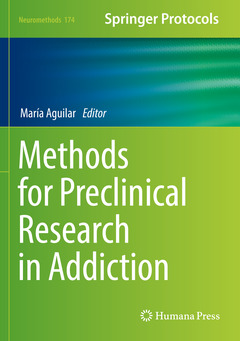Description
Methods for Preclinical Research in Addiction, 1st ed. 2022
Neuromethods Series, Vol. 174
Language: English
Subject for Methods for Preclinical Research in Addiction:
Keywords
nicotine; cocaine; cannabinoids; psychostimulants; novelty-seeking trait
Publication date: 09-2021
Support: Print on demand
Publication date: 09-2021
333 p. · 17.8x25.4 cm · Hardback
Description
/li>Contents
/li>Comment
/li>
This volume presents a wide array of animal models that are used in the study of the individual and environmental factors involved in the development of addiction, the consequences of chronic drug exposure, and recently developed behavioral and biological procedures for the treatment of addictive disorders. The chapters in this book are organized into three sections that cover the aforementioned aspects in relation to different drugs of abuse and pathological gambling. The first section of the book focuses on the individual variables that affect vulnerability to addiction to nicotine, alcohol, cocaine, psychostimulants, and gambling. Section Two looks at the environmental variables that contribute to the vulnerability to addiction. Section Three explores the consequences of chronic drug consumption and new approaches to the treatment of addiction. In the Neuromethods series style, chapters include the kind of detail and key advice from the specialists needed to get successful results in your laboratory.
Cutting-edge and comprehensive, Methods for Preclinical Research in Addiction is a valuable resource that helps researchers and scientists understand the neurobiological mechanisms that underlie the influence of individual and environmental variables on the risk for addiction, and assists them in developing new behavioral and pharmacological strategies to prevent and treat addictive disorders.
Series Preface…
Preface…
Table of Contents…
Contributing Authors…
Part I Individual Variables of Vulnerability to Addiction
1. Influence of Sex on the Effects of Nicotine and Other Drugs of Abuse on Intracranial Self-Stimulation
Ranjithkumar Chellian, Ryann Wilson, Azin Behnood-Rod, and Adriaan W. Bruijnzeel
2. Animal Models of Adolescent Binge Drinking
Santiago Monleón, Rosa Redolat, Aránzazu Duque, Patricia Mesa-Gresa, and Concepción Vinader-Caerols
3. Prepulse Inhibition and Vulnerability to Cocaine Addiction
M. Carmen Arenas, Sergio Pujante-Gil, and Carmen Manzanedo
4. Modulation of the Effects of Alcohol, Cannabinoids, and Psychostimulants by the Novelty-Seeking Trait
Claudia Calpe-López, M. Ángeles Martínez-Caballero, M. Pilar García-Pardo, and María A. Aguilar
5. Cognitive Biases Associated with Vulnerability to the Development of Pathological Gambling
Rafal Rygula, Justyna K. Hinchcliffe, and Karolina Noworyta
Part II Environmental Variables of Vulnerability to Addiction
6. Extended Drug Access and Escalation of Drug-Self Administration
Florence Allain, Ndeye Aissatou Ndiaye, and Anne-Noël Samaha
7. Preclinical Models of Relapse to Psychostimulants Induced by Environmental Stimuli
Anna Maria Borruto, Ana Domi, Laura Soverchia, Esi Domi, Hongwu Li, and Nazzareno Cannella
8. Influence of Social Defeat Stress on the Rewarding Effects of Drugs of Abuse
María Pilar García-Pardo, José Enrique De la Rubia Ortí, Claudia Calpe-López, M. Ángeles Martínez-Caballero, and María A. Aguilar
9. Environmental Enrichment and the Effects on Drug Abuse Vulnerability: The Last Ten Years
Dustin J. Stairs, Taena Hanson, and Kendall Kellerman
Part III Consequences of Chronic Drug Consumption and Treatment of Addiction
10. Investigation of Individual Differences in Stress Susceptibility and Drug-Seeking in an Animal Model of SUD/PTSD Comorbidity
Courtney S. Wilkinson, Harrison L. Blount, Lori A. Knackstedt, and Marek Schwendt
11. Working and Reference Memory Impairments Induced by Passive Chronic Cocaine Administration in Mice
M. Carmen Mañas Padilla, Fabiola Ávila Gámiz, Sara Gil Rodríguez, Lourdes Sánchez Salido, Luis J. Santín, and Estela Castilla Ortega
12. Transcranial Direct Current Stimulation to Reduce Addiction-Related Behaviors in Mice
Stéphanie Dumontoy, Adeline Etievant, Andries Van Schuerbeek, and Vincent Van Waes
13. Manipulating Reconsolidation to Erase Drug Memory
Amy L. Milton
Subject Index List…
Includes cutting-edge methods and protocols
Provides step-by-step detail essential for reproducible results
Contains key notes and implementation advice from the experts




